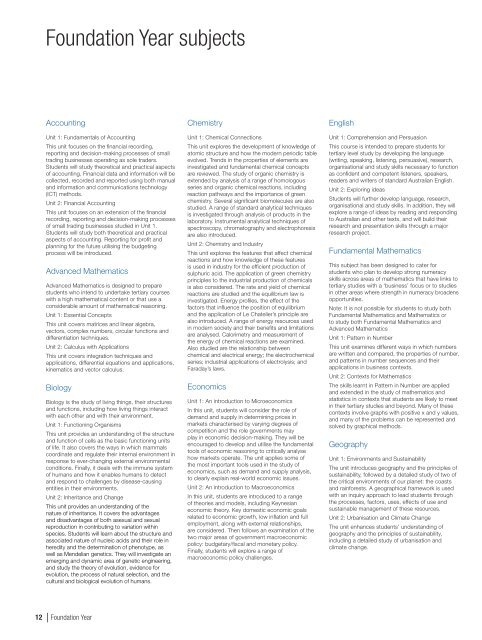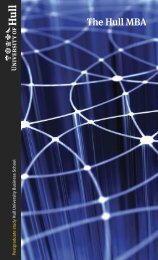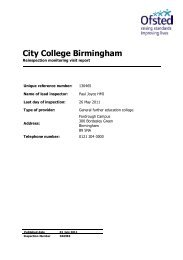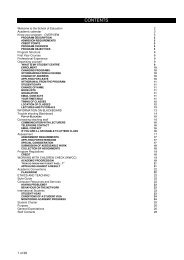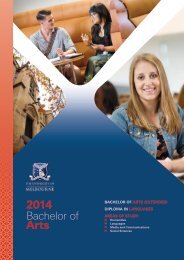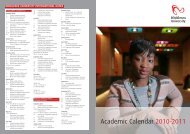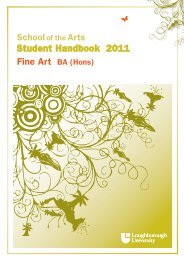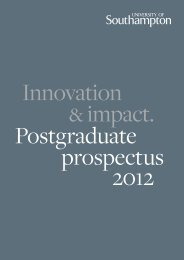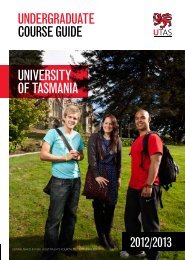Monash College International Student Guide - Study in the UK
Monash College International Student Guide - Study in the UK
Monash College International Student Guide - Study in the UK
You also want an ePaper? Increase the reach of your titles
YUMPU automatically turns print PDFs into web optimized ePapers that Google loves.
Foundation Year subjects<br />
Account<strong>in</strong>g<br />
Unit 1: Fundamentals of Account<strong>in</strong>g<br />
This unit focuses on <strong>the</strong> f<strong>in</strong>ancial record<strong>in</strong>g,<br />
report<strong>in</strong>g and decision-mak<strong>in</strong>g processes of small<br />
trad<strong>in</strong>g bus<strong>in</strong>esses operat<strong>in</strong>g as sole traders.<br />
<strong>Student</strong>s will study <strong>the</strong>oretical and practical aspects<br />
of account<strong>in</strong>g. F<strong>in</strong>ancial data and <strong>in</strong>formation will be<br />
collected, recorded and reported us<strong>in</strong>g both manual<br />
and <strong>in</strong>formation and communications technology<br />
(ICT) methods.<br />
Unit 2: F<strong>in</strong>ancial Account<strong>in</strong>g<br />
This unit focuses on an extension of <strong>the</strong> f<strong>in</strong>ancial<br />
record<strong>in</strong>g, report<strong>in</strong>g and decision-mak<strong>in</strong>g processes<br />
of small trad<strong>in</strong>g bus<strong>in</strong>esses studied <strong>in</strong> Unit 1.<br />
<strong>Student</strong>s will study both <strong>the</strong>oretical and practical<br />
aspects of account<strong>in</strong>g. Report<strong>in</strong>g for profit and<br />
plann<strong>in</strong>g for <strong>the</strong> future utilis<strong>in</strong>g <strong>the</strong> budget<strong>in</strong>g<br />
process will be <strong>in</strong>troduced.<br />
Advanced Ma<strong>the</strong>matics<br />
Advanced Ma<strong>the</strong>matics is designed to prepare<br />
students who <strong>in</strong>tend to undertake tertiary courses<br />
with a high ma<strong>the</strong>matical content or that use a<br />
considerable amount of ma<strong>the</strong>matical reason<strong>in</strong>g.<br />
Unit 1: Essential Concepts<br />
This unit covers matrices and l<strong>in</strong>ear algebra,<br />
vectors, complex numbers, circular functions and<br />
differentiation techniques.<br />
Unit 2: Calculus with Applications<br />
This unit covers <strong>in</strong>tegration techniques and<br />
applications, differential equations and applications,<br />
k<strong>in</strong>ematics and vector calculus.<br />
Biology<br />
Biology is <strong>the</strong> study of liv<strong>in</strong>g th<strong>in</strong>gs, <strong>the</strong>ir structures<br />
and functions, <strong>in</strong>clud<strong>in</strong>g how liv<strong>in</strong>g th<strong>in</strong>gs <strong>in</strong>teract<br />
with each o<strong>the</strong>r and with <strong>the</strong>ir environment.<br />
Unit 1: Function<strong>in</strong>g Organisms<br />
This unit provides an understand<strong>in</strong>g of <strong>the</strong> structure<br />
and function of cells as <strong>the</strong> basic function<strong>in</strong>g units<br />
of life. It also covers <strong>the</strong> ways <strong>in</strong> which mammals<br />
coord<strong>in</strong>ate and regulate <strong>the</strong>ir <strong>in</strong>ternal environment <strong>in</strong><br />
response to ever-chang<strong>in</strong>g external environmental<br />
conditions. F<strong>in</strong>ally, it deals with <strong>the</strong> immune system<br />
of humans and how it enables humans to detect<br />
and respond to challenges by disease-caus<strong>in</strong>g<br />
entities <strong>in</strong> <strong>the</strong>ir environments.<br />
Unit 2: Inheritance and Change<br />
This unit provides an understand<strong>in</strong>g of <strong>the</strong><br />
nature of <strong>in</strong>heritance. It covers <strong>the</strong> advantages<br />
and disadvantages of both asexual and sexual<br />
reproduction <strong>in</strong> contribut<strong>in</strong>g to variation with<strong>in</strong><br />
species. <strong>Student</strong>s will learn about <strong>the</strong> structure and<br />
associated nature of nucleic acids and <strong>the</strong>ir role <strong>in</strong><br />
heredity and <strong>the</strong> determ<strong>in</strong>ation of phenotype, as<br />
well as Mendelian genetics. They will <strong>in</strong>vestigate an<br />
emerg<strong>in</strong>g and dynamic area of genetic eng<strong>in</strong>eer<strong>in</strong>g,<br />
and study <strong>the</strong> <strong>the</strong>ory of evolution, evidence for<br />
evolution, <strong>the</strong> process of natural selection, and <strong>the</strong><br />
cultural and biological evolution of humans.<br />
Chemistry<br />
Unit 1: Chemical Connections<br />
This unit explores <strong>the</strong> development of knowledge of<br />
atomic structure and how <strong>the</strong> modern periodic table<br />
evolved. Trends <strong>in</strong> <strong>the</strong> properties of elements are<br />
<strong>in</strong>vestigated and fundamental chemical concepts<br />
are reviewed. The study of organic chemistry is<br />
extended by analysis of a range of homologous<br />
series and organic chemical reactions, <strong>in</strong>clud<strong>in</strong>g<br />
reaction pathways and <strong>the</strong> importance of green<br />
chemistry. Several significant biomolecules are also<br />
studied. A range of standard analytical techniques<br />
is <strong>in</strong>vestigated through analysis of products <strong>in</strong> <strong>the</strong><br />
laboratory. Instrumental analytical techniques of<br />
spectroscopy, chromatography and electrophoresis<br />
are also <strong>in</strong>troduced.<br />
Unit 2: Chemistry and Industry<br />
This unit explores <strong>the</strong> features that affect chemical<br />
reactions and how knowledge of <strong>the</strong>se features<br />
is used <strong>in</strong> <strong>in</strong>dustry for <strong>the</strong> efficient production of<br />
sulphuric acid. The application of green chemistry<br />
pr<strong>in</strong>ciples to <strong>the</strong> <strong>in</strong>dustrial production of chemicals<br />
is also considered. The rate and yield of chemical<br />
reactions are studied and <strong>the</strong> equilibrium law is<br />
<strong>in</strong>vestigated. Energy profiles, <strong>the</strong> effect of <strong>the</strong><br />
factors that <strong>in</strong>fluence <strong>the</strong> position of equilibrium<br />
and <strong>the</strong> application of Le Chatelier’s pr<strong>in</strong>ciple are<br />
also <strong>in</strong>troduced. A range of energy resources used<br />
<strong>in</strong> modern society and <strong>the</strong>ir benefits and limitations<br />
are analysed. Calorimetry and measurement of<br />
<strong>the</strong> energy of chemical reactions are exam<strong>in</strong>ed.<br />
Also studied are <strong>the</strong> relationship between<br />
chemical and electrical energy; <strong>the</strong> electrochemical<br />
series; <strong>in</strong>dustrial applications of electrolysis; and<br />
Faraday’s laws.<br />
Economics<br />
Unit 1: An <strong>in</strong>troduction to Microeconomics<br />
In this unit, students will consider <strong>the</strong> role of<br />
demand and supply <strong>in</strong> determ<strong>in</strong><strong>in</strong>g prices <strong>in</strong><br />
markets characterised by vary<strong>in</strong>g degrees of<br />
competition and <strong>the</strong> role governments may<br />
play <strong>in</strong> economic decision-mak<strong>in</strong>g. They will be<br />
encouraged to develop and utilise <strong>the</strong> fundamental<br />
tools of economic reason<strong>in</strong>g to critically analyse<br />
how markets operate. The unit applies some of<br />
<strong>the</strong> most important tools used <strong>in</strong> <strong>the</strong> study of<br />
economics, such as demand and supply analysis,<br />
to clearly expla<strong>in</strong> real-world economic issues.<br />
Unit 2: An <strong>in</strong>troduction to Macroeconomics<br />
In this unit, students are <strong>in</strong>troduced to a range<br />
of <strong>the</strong>ories and models, <strong>in</strong>clud<strong>in</strong>g Keynesian<br />
economic <strong>the</strong>ory. Key domestic economic goals<br />
related to economic growth, low <strong>in</strong>flation and full<br />
employment, along with external relationships,<br />
are considered. Then follows an exam<strong>in</strong>ation of <strong>the</strong><br />
two major areas of government macroeconomic<br />
policy: budgetary/fiscal and monetary policy.<br />
F<strong>in</strong>ally, students will explore a range of<br />
macroeconomic policy challenges.<br />
English<br />
Unit 1: Comprehension and Persuasion<br />
This course is <strong>in</strong>tended to prepare students for<br />
tertiary level study by develop<strong>in</strong>g <strong>the</strong> language<br />
(writ<strong>in</strong>g, speak<strong>in</strong>g, listen<strong>in</strong>g, persuasive), research,<br />
organisational and study skills necessary to function<br />
as confident and competent listeners, speakers,<br />
readers and writers of standard Australian English.<br />
Unit 2: Explor<strong>in</strong>g ideas<br />
<strong>Student</strong>s will fur<strong>the</strong>r develop language, research,<br />
organisational and study skills. In addition, <strong>the</strong>y will<br />
explore a range of ideas by read<strong>in</strong>g and respond<strong>in</strong>g<br />
to Australian and o<strong>the</strong>r texts, and will build <strong>the</strong>ir<br />
research and presentation skills through a major<br />
research project.<br />
Fundamental Ma<strong>the</strong>matics<br />
This subject has been designed to cater for<br />
students who plan to develop strong numeracy<br />
skills across areas of ma<strong>the</strong>matics that have l<strong>in</strong>ks to<br />
tertiary studies with a ‘bus<strong>in</strong>ess’ focus or to studies<br />
<strong>in</strong> o<strong>the</strong>r areas where strength <strong>in</strong> numeracy broadens<br />
opportunities.<br />
Note: It is not possible for students to study both<br />
Fundamental Ma<strong>the</strong>matics and Ma<strong>the</strong>matics or<br />
to study both Fundamental Ma<strong>the</strong>matics and<br />
Advanced Ma<strong>the</strong>matics<br />
Unit 1: Pattern <strong>in</strong> Number<br />
This unit exam<strong>in</strong>es different ways <strong>in</strong> which numbers<br />
are written and compared, <strong>the</strong> properties of number,<br />
and patterns <strong>in</strong> number sequences and <strong>the</strong>ir<br />
applications <strong>in</strong> bus<strong>in</strong>ess contexts.<br />
Unit 2: Contexts for Ma<strong>the</strong>matics<br />
The skills learnt <strong>in</strong> Pattern <strong>in</strong> Number are applied<br />
and extended <strong>in</strong> <strong>the</strong> study of ma<strong>the</strong>matics and<br />
statistics <strong>in</strong> contexts that students are likely to meet<br />
<strong>in</strong> <strong>the</strong>ir tertiary studies and beyond. Many of <strong>the</strong>se<br />
contexts <strong>in</strong>volve graphs with positive x and y values,<br />
and many of <strong>the</strong> problems can be represented and<br />
solved by graphical methods.<br />
Geography<br />
Unit 1: Environments and Susta<strong>in</strong>ability<br />
The unit <strong>in</strong>troduces geography and <strong>the</strong> pr<strong>in</strong>ciples of<br />
susta<strong>in</strong>ability, followed by a detailed study of two of<br />
<strong>the</strong> critical environments of our planet: <strong>the</strong> coasts<br />
and ra<strong>in</strong>forests. A geographical framework is used<br />
with an <strong>in</strong>quiry approach to lead students through<br />
<strong>the</strong> processes, factors, uses, effects of use and<br />
susta<strong>in</strong>able management of <strong>the</strong>se resources.<br />
Unit 2: Urbanisation and Climate Change<br />
The unit enhances students’ understand<strong>in</strong>g of<br />
geography and <strong>the</strong> pr<strong>in</strong>ciples of susta<strong>in</strong>ability,<br />
<strong>in</strong>clud<strong>in</strong>g a detailed study of urbanisation and<br />
climate change.<br />
12 | Foundation Year


